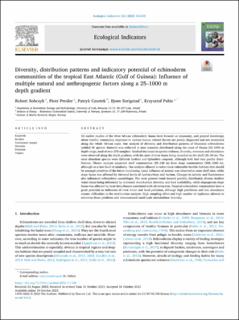| dc.contributor.author | Robert, Sobczyk | |
| dc.contributor.author | Piotr, Presler | |
| dc.contributor.author | Patryk, Czortek | |
| dc.contributor.author | Serigstad, Bjørn | |
| dc.contributor.author | Krzysztof, Pabis | |
| dc.date.accessioned | 2023-12-04T09:25:26Z | |
| dc.date.available | 2023-12-04T09:25:26Z | |
| dc.date.created | 2023-11-07T14:48:17Z | |
| dc.date.issued | 2023 | |
| dc.identifier.citation | Ecological Indicators. 2023, 156 . | |
| dc.identifier.issn | 1470-160X | |
| dc.identifier.uri | https://hdl.handle.net/11250/3105761 | |
| dc.description.abstract | All earlier studies of the West African echinoderm fauna have focused on taxonomy, and general knowledge about benthic community responses to various human related threats are poorly diagnosed and not monitored along the whole African coast. Our analysis of diversity and distribution patterns of Ghanaian echinoderms yielded 36 species. Material was collected at nine transects distributed along the coast of Ghana (25–1000 m depth range, total of over 270 samples). Gradual decreases in species richness, diversity, evenness and abundance were observed along the depth gradient, with the most diverse fauna being recorded on the shelf (25–50 m). The most abundant species were Ophiactis luetkeni and Ophiothrix congensis, although both had very patchy distributions. Cluster analysis separated shelf communities (25–100 m) from slope communities (500–1000 m), although on a low level of similarity. Our analysis allowed to select most vulnerable benthic habitats that should be amongst priorities of the future monitoring. Local influence of arsenic was observed at some shelf sites, while slope fauna was affected by elevated levels of hydrocarbons and barium. Changes in salinity and fluorescence also influenced echinoderm assemblages. The most general trend showed patchily distributed, diverse shallow water fauna being influenced by increased microhabitat diversity and food availability, while depauperate slope fauna was affected by local disturbances associated with oil extraction. Tropical echinoderm communities have a great potential as indicators of even minor and local pollution, although high patchiness and low abundance creates difficulties in the multivariate analysis. High sampling effort and high number of replicates allowed to minimise those problems and demonstrated small scale microhabitat diversity. | |
| dc.language.iso | eng | |
| dc.title | Diversity, distribution patterns and indicatory potential of echinoderm communities of the tropical East Atlantic (Gulf of Guinea): Influence of multiple natural and anthropogenic factors along a 25–1000 m depth gradient | |
| dc.title.alternative | Diversity, distribution patterns and indicatory potential of echinoderm communities of the tropical East Atlantic (Gulf of Guinea): Influence of multiple natural and anthropogenic factors along a 25–1000 m depth gradient | |
| dc.type | Peer reviewed | |
| dc.type | Journal article | |
| dc.description.version | publishedVersion | |
| dc.source.pagenumber | 17 | |
| dc.source.volume | 156 | |
| dc.source.journal | Ecological Indicators | |
| dc.identifier.doi | 10.1016/j.ecolind.2023.111108 | |
| dc.identifier.cristin | 2193398 | |
| cristin.ispublished | true | |
| cristin.fulltext | original | |
| cristin.qualitycode | 1 | |
